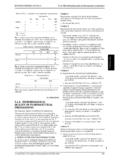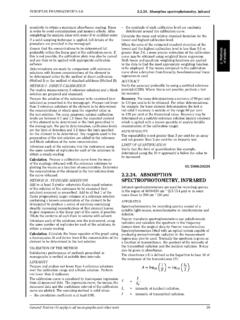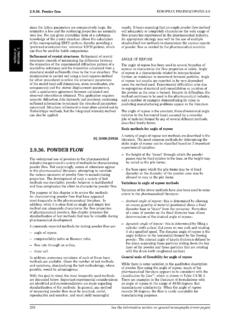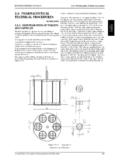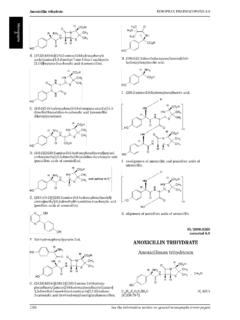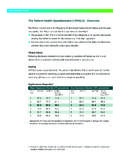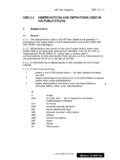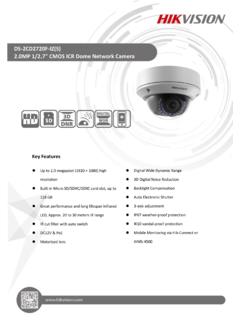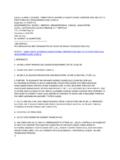Transcription of 2.2.25. ABSORPTION SPECTROPHOTOMETRY, …
1 EUROPEAN PHARMACOPOEIA ABSORPTION spectrophotometry , ultraviolet and visible IMPURITIES IN GASES. For the analysis of impurities, use a cell transparent to infrared radiation and of suitable optical path length (for example, 1-20 m). Fill the cell as prescribed under Gases. For detection and quantification of the impurities, proceed as prescribed in the monograph. 01/2008:20225. ABSORPTION . spectrophotometry , ultraviolet AND visible . Determination of absorbance. The absorbance (A) of a solution is defined as the logarithm to base 10 of the reciprocal of the transmittance (T) for monochromatic radiation : Figure Typical spectrum of polystyrene used to verify the resolution performance T = I/I0.
2 Verification of the wave-number scale. The wave-number scale may be verified using a polystyrene film, which has I0 = intensity of incident monochromatic radiation ;. transmission minima ( ABSORPTION maxima) at the wave I = intensity of transmitted monochromatic radiation. numbers (in cm 1) shown in Table In the absence of other physico-chemical factors, the Table Transmission minima and acceptable absorbance (A) is proportional to the path length (b) through tolerances of a polystyrene film which the radiation passes and to the concentration (c) of Transmission Acceptable tolerance (cm 1). the substance in solution in accordance with the equation : minima (cm 1).
3 Monochromator Fourier-transform instruments instruments = molar absorptivity, if b is expressed in centimetres and c in moles per litre. The expression representing the specific absorbance of a dissolved substance refers to the absorbance of a 10 g/l solution in a 1 cm cell and measured at a defined wavelength so that : Unless otherwise prescribed, measure the absorbance at the prescribed wavelength using a path length of 1 cm. Unless otherwise prescribed, the measurements are carried out Method. Prepare the substance to be examined with reference to the same solvent or the same mixture of according to the instructions accompanying the reference solvents.
4 The absorbance of the solvent measured against air spectrum/reference substance. Using the operating and at the prescribed wavelength shall not exceed and is conditions that were used to obtain the reference spectrum, preferably less than Plot the ABSORPTION spectrum with which will usually be the same as those for verifying absorbance or function of absorbance as ordinate against the resolution performance, record the spectrum of the wavelength or function of wavelength as abscissa. substance to be examined. Where a monograph gives a single value for the position The positions and the relative sizes of the bands in the of an ABSORPTION maximum, it is understood that the value spectrum of the substance to be examined and the reference obtained may differ by not more than 2 nm.
5 Spectrum are concordant in the 2 spectra. Apparatus. Spectrophotometers suitable for measuring in Compensation for water vapour and atmospheric carbon the ultraviolet and visible range of the spectrum consist dioxide. For Fourier-transform instruments, spectral of an optical system capable of producing monochromatic interference from water vapour and carbon dioxide is radiation in the range of 200-800 nm and a device suitable compensated using suitable algorithms according to the for measuring the absorbance. manufacturer's instructions. Alternatively, spectra can be Control of wavelengths. Verify the wavelength scale using acquired using suitable purged instruments or ensuring that the ABSORPTION maxima of holmium perchlorate solution R, sample and background single beam spectra are acquired the line of a hydrogen or deuterium discharge lamp or the under exactly the same conditions.
6 Lines of a mercury vapour arc shown in Table The General Notices (1) apply to all monographs and other texts 41. ABSORPTION spectrophotometry , ultraviolet and visible EUROPEAN PHARMACOPOEIA permitted tolerance is 1 nm for the ultraviolet range and Cells. The tolerance on the path length of the cells used is 3 nm for the visible range. Suitable certified reference cm. When filled with the same solvent, the cells materials may also be used. intended to contain the solution to be examined and the compensation liquid must have the same transmittance. Table ABSORPTION maxima for control of If this is not the case, an appropriate correction must be wavelength scale applied.
7 Nm (Ho) nm (Hg) The cells must be cleaned and handled with care. nm (Hg) nm (Hg) DERIVATIVE spectrophotometry . nm (Ho) nm (D ) Derivative spectrophotometry involves the transformation nm (Hg) nm (H ). of ABSORPTION spectra (zero-order) into first-, second- or higher-order-derivative spectra. nm (Hg) nm (Ho). A first-order-derivative spectrum is a plot of the gradient of nm (Hg) nm (Hg) the ABSORPTION curve (rate of change of the absorbance with nm (Ho) nm (Hg). wavelength, dA/d ) against wavelength. A second-order-derivative spectrum is a plot of the curvature nm (Hg) nm (Hg) of the ABSORPTION spectrum against wavelength (d2A/d 2). The second-order-derivative spectrum at any wavelength is Control of absorbance.
8 Check the absorbance using related to concentration by the following equation : suitable filters or a solution of potassium dichromate R at the wavelengths indicated in Table , which gives for each wavelength the exact value and the permitted limits of the specific absorbance. The table is based on a tolerance for the absorbance of c = concentration of the absorbing solute, in grams For the control of absorbance, use solutions of potassium per litre. dichromate R that has been previously dried to constant Apparatus. Use a spectrophotometer complying with mass at 130 C. For the control of absorbance at 235 nm, the requirements prescribed above and equipped with an 257 nm, 313 nm and 350 nm, dissolve mg of analogue resistance-capacitance differentiation module or a potassium dichromate R in M sulphuric acid and digital differentiator or other means of producing derivative dilute to ml with the same acid.
9 For the control of spectra. Some methods of producing second-order-derivative absorbance at 430 nm, dissolve mg of potassium spectra produce a wavelength shift relative to the zero-order dichromate R in M sulphuric acid and dilute to spectrum and this is to be taken into account where ml with the same acid. Suitable certified reference applicable. materials may also be used. Table Wavelength Specific absorbance Maximum (nm) tolerance 235 to 257 to 313 to 350 to 430 to Limit of stray light. Stray light may be detected at a given wavelength with suitable filters or solutions : for example, the absorbance of a 12 g/l solution of potassium chloride R.
10 In a 1 cm cell increases steeply between 220 nm and 200 nm and is greater than at 198 nm when compared with water as compensation liquid. Suitable certified reference materials may also be used. Resolution (for qualitative analysis). When prescribed in a monograph, measure the resolution of the apparatus as follows : record the spectrum of a per cent V/V. solution of toluene R in hexane R. The minimum ratio of the absorbance at the maximum at 269 nm to that at the minimum at 266 nm is stated in the monograph. Suitable certified reference materials may also be used. Spectral slit-width (for quantitative analysis). To avoid errors due to spectral slit-width, when using an instrument on which the slit-width is variable at the selected wavelength, the slit-width must be small compared with the half-width of the ABSORPTION band but it must be as large as possible to Figure obtain a high value of I0.
